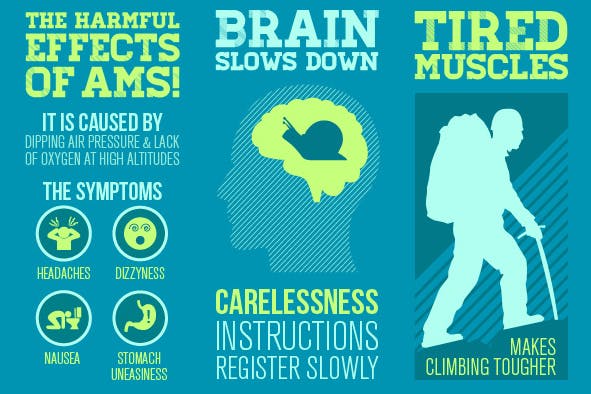High Altitude Sickness

What is high altitude sickness?
Ascending to or being at a new high altitude may cause high-altitude sickness. High altitude sickness includes acute mountain sickness (AMS), high-altitude cerebral edema (HACE) and high-altitude pulmonary edema (HAPE). High altitude sickness is a condition that occurs when people ascend to high altitudes (usually above 8,000 feet or 2,400 meters) too quickly without acclimatizing properly. Altitude sickness is caused by a lack of oxygen in the air, which can lead to a range of symptoms that can range from mild to life-threatening.

Acute mountain sickness (AMS)
Acute mountain sickness (AMS) is the most common of the altitude diseases; it occurs in approximately 40 to 50 percent of people who live at a low altitude and sleep at an altitude above 10,000 feet (3000 m), and in approximately 25 percent of those sleeping above 8000 feet (2400 m). Some people can develop AMS as low as 6500 feet (2000 m).
High-altitude cerebral edema (HACE)
High-altitude cerebral edema (HACE) is a rare, life-threatening altitude disease and is a severe form of acute mountain sickness (AMS). It is caused by leaky capillaries in the brain, which causes fluid accumulation and brain swelling. You may experience confusion, lack of coordination and possibly violent behaviour.
High-altitude Pulmonary Edema (HAPE)
High-altitude pulmonary edema (HAPE) is a potentially fatal condition in which lung capillaries leak and fluid accumulates in the lungs, causing breathlessness, even when resting. You feel very fatigued and weak and may feel like you’re suffocating. HAPE is uncommon but can occur in people who rapidly ascend to altitudes above 8200 feet (2500 m).

Symptoms
The symptoms of high-altitude sickness can range from mild to severe and usually appear within 6 to 24 hours after arrival at high altitude. The most common symptoms include:
- Headache
- Nausea
- Vomiting
- Fatigue
- Loss of appetite
- Dizziness
- Insomnia
- Shortness of breath
- Rapid heart rate
In severe cases, high altitude sickness can progress to high altitude cerebral edema (HACE) or high altitude pulmonary edema (HAPE), which can be life-threatening.
Risk Factors
It is not possible to know in advance if you will become ill when traveling to a high altitude. In addition, being physically fit does not decrease your chances of developing a high-altitude illness. However, certain groups are at increased risk, including people who:
- Have a prior history of high-altitude illness
- Overexert themselves before adjusting to the change in altitude
- Ascend rapidly (eg, within one day) from low elevation to sleeping altitudes above 9000 feet (2750 m)
- Have a medical problem that affects breathing
Treatment
The treatment for high altitude sickness depends on the severity of the condition. Mild symptoms of altitude sickness can often be relieved by descending to a lower altitude, resting, oxygen therapy and taking over-the-counter pain medications such as acetaminophen or ibuprofen. However, more severe cases of altitude sickness may require medical attention. Here are some treatments for high altitude sickness:
1. Medication
- Acetazolamide (Diamox) can help alleviate symptoms of altitude sickness by stimulating breathing and reducing fluid buildup in the lungs. However, it is important to consult with a healthcare provider before taking any medication.
- Dexamethasone is a steroid medication that can be used to treat severe cases of altitude sickness, such as high altitude cerebral edema (HACE).
2. Oxygen therapy
If you experience severe altitude sickness symptoms, oxygen therapy may be necessary to alleviate symptoms and prevent further complications.
Prevention
- Gradual ascent. The best way to prevent high altitude sickness is to acclimatize properly. This involves gradually ascending to higher altitudes over several days, allowing the body to adjust to the lower oxygen levels.
- Staying hydrated. Dehydration can worsen altitude sickness symptoms. Drink plenty of fluids, even if you don’t feel thirsty.
- Eating a well-balanced diet. Eat a diet that’s more than70% carbohydrate as can help provide the energy and nutrients needed to cope with the physical stress of high altitude.
- Avoiding alcohol. Alcohol can dehydrate your body. It also has stronger effects at higher elevations, which can impair judgment.
- Rest. Take it easy for the first few days after reaching high altitude. Avoid strenuous activity until you feel acclimatized.
- “Climb high and sleep low”. If you have to climb over 1,000 feet in a day, make sure you come back down to a lower altitude to sleep.
- Recognize symptoms. Be aware of the symptoms of altitude sickness and take action if they appear. Early recognition and treatment can prevent the condition from becoming more severe.
References
- Altitude Sickness: What to Know?. https://www.webmd.com/a-to-z-guides/altitude-sickness
- Altitude sickness. https://www.nhs.uk/conditions/altitude-sickness/#:~:text=You%20can%20get%20altitude%20sickness,a%20medical%20emergency%20if%20ignored.
- Patient education: High-altitude illness (including mountain sickness) (Beyond the Basics). https://www.uptodate.com/contents/high-altitude-illness-including-mountain-sickness-beyond-the-basics/print
- Cleveland Clinic. Altitude Sickness. Available from https://my.clevelandclinic.org/health/diseases/15111-altitude-sickness




